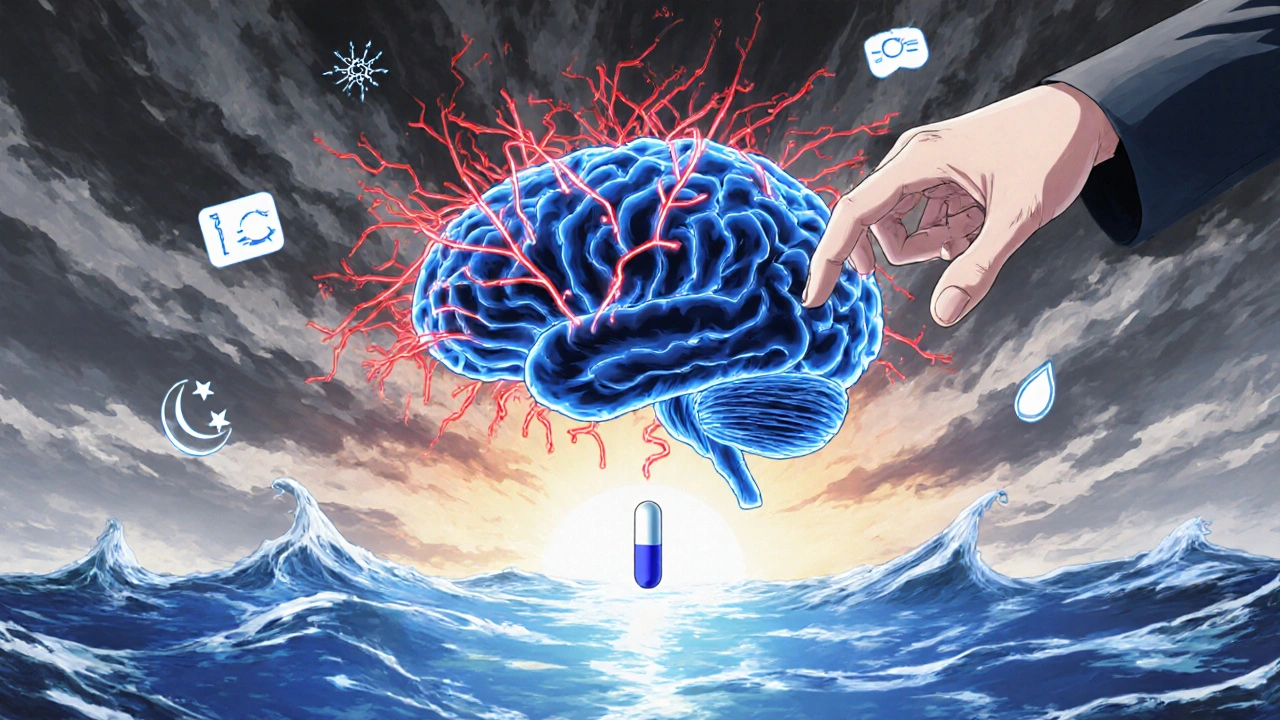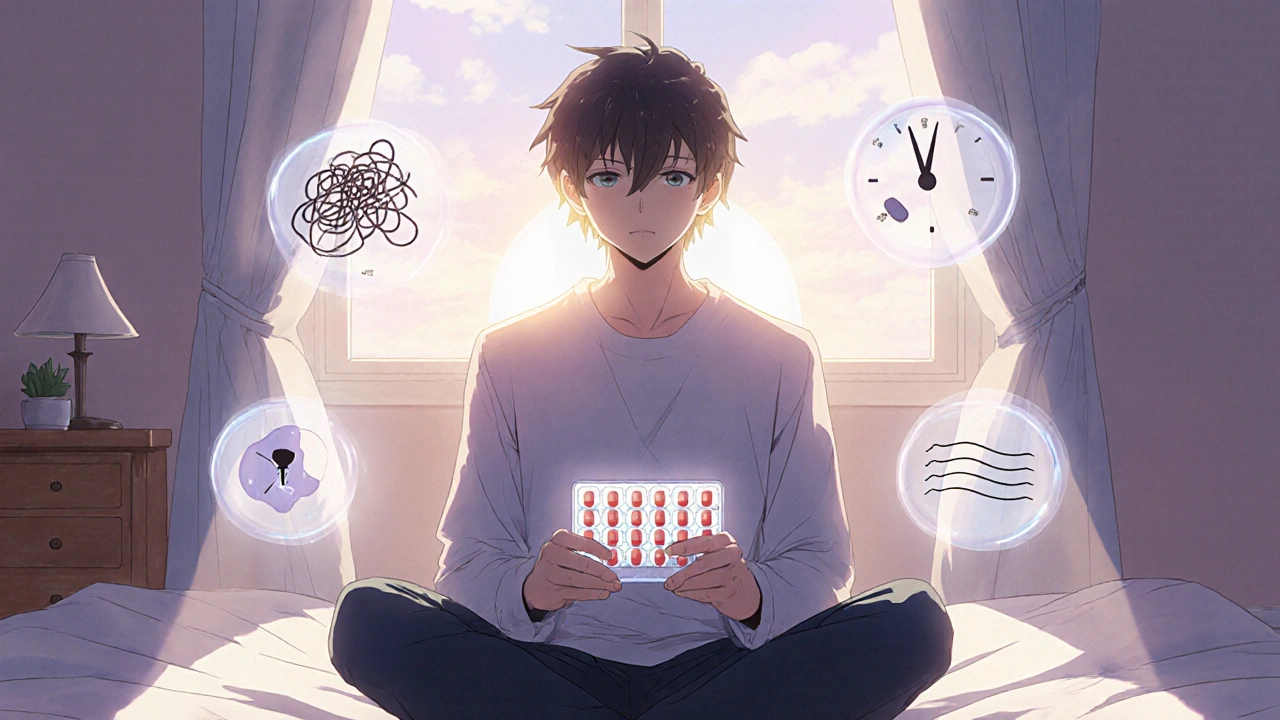Stopping benzodiazepines cold turkey can be dangerous. For people who’ve been taking them for months or years-whether for anxiety, insomnia, or muscle spasms-sudden discontinuation can trigger seizures, panic attacks so severe they feel like heart attacks, or even psychosis. The good news? You don’t have to quit all at once. With the right plan, most people can safely reduce their dose and regain control without risking their health.
Why Tapering Matters More Than Ever
In 2022, over 30 million Americans used benzodiazepines like Xanax, Valium, or Klonopin. About 17% of those users took them long-term-more than 120 days. That’s millions of people living with a medication that, over time, changes how the brain responds to stress. The body starts relying on the drug to feel calm. When it’s gone, the nervous system goes into overdrive. The FDA flagged this risk back in 2019, requiring drug labels to warn about the dangers of abrupt discontinuation. Since then, medical guidelines have evolved. In 2024, ten major medical societies-including psychiatry, addiction medicine, and geriatrics-released a unified clinical guideline. Their message is clear: if you’ve been on benzodiazepines for more than a month, tapering isn’t optional. It’s the standard of care.How Fast Should You Taper?
There’s no single timeline that fits everyone. But the safest starting point is reducing your daily dose by 5% to 10% every two to four weeks. This slow pace gives your brain time to readjust without triggering severe withdrawal. The Oregon Health Authority breaks it down by duration of use:- 2-8 weeks of use: taper over at least 2 weeks
- 8 weeks to 6 months: taper over at least 4 weeks
- 6 months to 1 year: taper over at least 8 weeks
- More than 1 year: taper over 6 to 18 months
Choosing the Right Medication for Tapering
Not all benzodiazepines are the same. Short-acting ones like alprazolam (Xanax) and triazolam (Halcion) leave your system quickly. That means withdrawal symptoms hit harder and sooner. Longer-acting ones like diazepam (Valium) stay in your body longer, smoothing out the drop. That’s why many doctors switch patients from Xanax to diazepam before tapering. The conversion is precise: 1 mg of alprazolam equals 20 mg of diazepam. This swap lets you make smaller, more manageable dose reductions. It’s not about replacing one drug with another-it’s about making the exit smoother. Triazolam is an exception. Because it doesn’t usually cause physical dependence, it can sometimes be stopped without a taper. But if you’ve been taking it daily for months, even this rule can change. Always check with your doctor.What Withdrawal Symptoms to Watch For
Withdrawal doesn’t always mean panic attacks. Sometimes it’s subtle:- Increased anxiety-even if you feel like you’re "just being sensitive"
- Insomnia that won’t go away, even with sleep aids
- Tremors in your hands or a racing heartbeat
- Sensitivity to light, sound, or touch
- Brain zaps-a sudden electric-shock feeling in your head
- Dizziness or nausea

Who Should Be Extra Cautious
Some people need more support than others:- Older adults: Benzodiazepines increase fall risk and memory problems. The Beers Criteria lists them as potentially inappropriate for seniors.
- People with PTSD or chronic pain: The VA found that continuing benzos for PTSD increases death risk and blocks recovery from trauma-focused therapy.
- Those with a history of alcohol or opioid use: Combining benzos with other substances raises overdose risk and makes withdrawal more complex.
- People with brain injuries or cognitive decline: Their brains recover slower, so tapering must be slower too.
The Team Approach to Safe Tapering
The best outcomes happen when you’re not doing this by yourself. The VA recommends a team-based model:- A prescribing doctor who manages the taper schedule
- A clinical pharmacist who checks for drug interactions and ensures accurate dosing
- A therapist trained in cognitive behavioral therapy (CBT) to help manage anxiety without meds
- A peer support provider-someone who’s been through it themselves
Why CBT Is the Missing Piece
Medication alone won’t fix the underlying anxiety or sleep issues that led you to benzos in the first place. A 2024 study in JAMA Psychiatry found that people who combined tapering with CBT had a 68.3% success rate in fully stopping benzos. Those who only tapered medically? Just 42.1%. CBT teaches you how to sit with discomfort, challenge anxious thoughts, and build routines that support sleep without pills. It’s not a quick fix-it’s a skill set. And it lasts long after the last pill is gone.
What to Do If Symptoms Get Too Strong
If you’re struggling-really struggling-don’t panic. You’re not failing. You’re human. If withdrawal symptoms become unbearable:- Pause the taper for 1-2 weeks
- Hold at your current dose until symptoms settle
- Then try reducing again, but by a smaller amount-maybe 2-3% instead of 5%
What’s Next for Benzodiazepine Tapering
The future is digital. The NIH is funding a $2.4 million study testing a mobile app that tracks your symptoms daily and suggests dose adjustments based on your data. It’s not here yet-but it’s coming. In the meantime, state laws are catching up. Twenty-eight states now require doctors to create a formal tapering plan if a benzo prescription lasts longer than 90 days. The Department of Veterans Affairs has already cut long-term benzo use among veterans by 24% since 2020. By 2026, demand for specialists trained in tapering is expected to rise 35%. This isn’t a passing trend. It’s a medical shift.Final Thought: You’re Not Broken
If you’ve been on benzodiazepines for a long time, it doesn’t mean you’re weak. It means you were trying to cope with something hard. The fact that you’re even considering tapering shows strength. Tapering isn’t about quitting. It’s about reclaiming your nervous system. It’s about learning to feel anxious without needing a pill to silence it. It’s about sleeping through the night because your body can relax on its own. It takes time. It takes patience. But it’s possible. And you’re not alone.Can I taper off benzodiazepines on my own?
While some people do taper without medical help, it’s not recommended. Benzodiazepine withdrawal can be dangerous, especially if you’ve been taking high doses or long-acting versions. Seizures, severe anxiety, and psychosis are real risks. Working with a doctor ensures your taper is safe, monitored, and adjusted based on your symptoms. A pharmacist can also help with accurate dosing, and a therapist can support the psychological side.
How long does benzodiazepine withdrawal last?
Acute withdrawal symptoms usually peak within the first week after a dose reduction and fade over 1-2 weeks. But some people experience protracted withdrawal-milder symptoms like anxiety, brain fog, or sleep issues-that can last months. This is more common after long-term use or rapid tapers. Slowing down the taper reduces the risk of prolonged symptoms. Patience is key.
Is diazepam (Valium) better than Xanax for tapering?
Yes, for most people. Diazepam has a long half-life, meaning it stays in your system longer. This creates a smoother decline in drug levels, reducing withdrawal spikes. Xanax (alprazolam) is short-acting and causes sharper drops, making withdrawal more intense. Doctors often switch patients from Xanax to diazepam before tapering. The conversion is 1 mg of alprazolam = 20 mg of diazepam.
Can I use sleep aids or other anxiety meds during tapering?
Avoid other benzodiazepines or sleep meds like zolpidem-they can interfere with the taper and risk dependence. Non-addictive options like melatonin, magnesium, or low-dose trazodone may help with sleep. For anxiety, SSRIs (like sertraline) or SNRIs are often used long-term after benzos are stopped. Always discuss alternatives with your doctor before starting anything new.
What if I relapse and take a full dose again?
Relapsing doesn’t mean failure. It means your body needed more time to adjust. Don’t restart the taper from scratch. Stay at your current dose for a few weeks, then try reducing again by a smaller amount-maybe 2-3% instead of 5%. The goal is progress, not perfection. Many people taper successfully after one or more pauses.
Are there alternatives to benzodiazepines for anxiety and sleep?
Yes. For anxiety, SSRIs (like escitalopram) and SNRIs (like venlafaxine) are first-line treatments with no addiction risk. For sleep, CBT-I (Cognitive Behavioral Therapy for Insomnia) is more effective long-term than any pill. Other options include melatonin, magnesium glycinate, or low-dose trazodone. Lifestyle changes-like regular exercise, limiting caffeine, and sleep hygiene-also make a big difference.
How do I know if I should stop benzodiazepines?
Ask yourself: Are the benefits still worth the risks? If you’re taking them for more than a few months, the risks-like memory issues, falls, dependency, and reduced effectiveness-often outweigh the benefits. Especially if you’re over 65, have PTSD, or use alcohol or opioids. Talk to your doctor about your goals. If you’re taking benzos just to get through the day, it’s time to explore alternatives.



I’ve been on 0.5mg Xanax for 14 months. Tried cutting 10% every 3 weeks and hit a wall at 0.2mg-brain zaps, insomnia, and this weird metallic taste in my mouth for like 10 days straight. Slowed to 2% every 4 weeks and it’s been bearable. Still not done, but I can breathe again. No one warned me about the taste. Weird as hell.
Also, diazepam switch worked better than I expected. My doc had me on 10mg for a month before dropping. Felt like my nervous system finally got a chance to catch up.
Correction: 1 mg alprazolam = 10 mg diazepam, not 20. The Ashton Manual, the gold standard for benzodiazepine tapering, states a 1:10 ratio for equivalence. Your source is either outdated or misinformed. Please verify before spreading potentially dangerous misinformation. This isn’t just semantics-wrong conversions can lead to overdose or accelerated withdrawal.
Also, ‘brain zaps’ aren’t a real medical term. They’re colloquial for electric shock sensations associated with SSRI or benzodiazepine discontinuation. Precision matters.
Let me offer a broader perspective, grounded in both clinical experience and neuropharmacological literature. The notion that tapering is merely a matter of dose reduction is an oversimplification. What we’re truly addressing is synaptic reorganization-GABA-A receptor downregulation, glutamate excitotoxicity, and HPA axis dysregulation-all of which require not just pharmacological patience, but psychological recalibration.
Moreover, the VA’s team-based model isn’t just a recommendation-it’s a paradigm shift. We’re moving from a model of prescribing to one of restoration. The therapist isn’t an add-on; they’re the architect of neuroplastic adaptation. The pharmacist isn’t a dispenser; they’re the gatekeeper of pharmacokinetic integrity. And the peer? They’re the living proof that recovery is possible.
And for those who say, ‘I can do it alone’-yes, perhaps you can. But should you? The cost of failure isn’t just relapse-it’s trauma, hospitalization, and sometimes death. This isn’t a personal challenge. It’s a public health imperative.
Oh wow. So now we’re telling people they need a whole TEAM to quit a pill? Next they’ll require a therapist, a yoga instructor, a pet therapist, and a TikTok life coach to stop taking Tylenol.
Also, ‘brain zaps’? Really? Sounds like someone’s trying to make withdrawal sound like a supernatural experience. I’ve seen people quit cold turkey and be fine. This whole thing feels like overmedicalized fear-mongering.
And why is everyone acting like benzos are the devil? My grandma took Valium for 40 years. She’s 92, walks 3 miles a day, and still makes perfect pie. Maybe the problem isn’t the drug-it’s the narrative.
India has similar issues. Many doctors here prescribe alprazolam for months without taper plans. People come to me saying they can’t sleep without 2mg at night. I tell them to switch to diazepam, but they don’t trust me because I’m not a psychiatrist. Also, no one here knows about Ashton Manual. Even pharmacists don’t know the conversion ratios.
And CBT? We don’t have enough trained therapists. One therapist for 500 patients. What’s the point of guidelines if no one can follow them?
Also, why is everyone talking about Xanax? In India, it’s mostly clonazepam and bromazepam. Same problem, different brand names.
...and yet, we must ask: is the nervous system truly "reclaiming" itself-or is it merely reverting to a pre-drug state that was never healthy to begin with? The pill didn’t create the anxiety-it merely masked it. But what if the anxiety was never the problem? What if the problem was the world? The job? The loneliness? The algorithmic dread? The pill was a temporary sanctuary, not a moral failing.
So when we say "reclaim your nervous system," are we not also saying: "You must suffer without distraction?" And is that fair? Or is it just another form of societal coercion dressed in wellness jargon?
Perhaps the real taboo isn’t benzodiazepine use-it’s the expectation that we should be able to endure modern life without chemical aid.
...I’m not saying don’t taper. I’m saying: question the narrative behind the taper.
There’s something beautiful about this process-not because it’s easy, but because it’s human. You’re not just coming off a drug-you’re coming home to yourself. The tremors, the sleepless nights, the weird buzzing in your head-they’re not enemies. They’re messengers. Your body is rewiring. It’s grieving the crutch. It’s learning to hold its own weight again.
I watched my sister do this over 18 months. She cried in the shower every Sunday. She’d stare at her coffee cup and say, "I don’t know who I am without this." But then one day, she slept through the night. Not because she took a pill. Because she was tired. Truly, deeply tired. And her body finally let her rest.
You’re not broken. You’re becoming. And that’s worth every second of the ache.
So... you need a doctor, a pharmacist, a therapist, a peer, and a 2-year plan to quit a pill you got from a 5-minute telehealth visit?
Got it.
Meanwhile, my buddy quit Xanax cold turkey after 8 months, slept for 3 days straight, and hasn’t looked back. Guess he just didn’t read the right Reddit post.
Also, "brain zaps"? Sounds like someone’s trying to sell a mindfulness app.
Let’s be real-most of these tapering guidelines are written by people who’ve never taken benzos. They don’t know what 3am panic feels like when your heart’s pounding and your hands are shaking and you’re convinced you’re dying. They think 5% is fine. You try that after 2 years on 4mg/day and see how "manageable" it is.
And don’t get me started on the "CBT is magic" crowd. I did 20 sessions. It helped a little. But when your body is screaming for a pill, no amount of cognitive restructuring is gonna fix that. You need time. And patience. And maybe a little mercy.
WHY ARE WE STILL TALKING ABOUT THIS? BENZOS AREN’T DRUGS THEY’RE MEDICINES! MY DOCTOR PRESCRIBED THEM! I’M NOT A DRUGGIE! THE GOVERNMENT IS TRYING TO CONTROL US! THEY WANT US TO BE "OPTIMIZED" LIKE ROBOTS! WHY CAN’T I JUST TAKE MY PILLS IN PEACE?!?!?!?!!
Also, "brain zaps"? That’s not a real thing. That’s just anxiety. You’re just weak.
Just wanted to say-tapered off Klonopin after 7 years. Took 14 months. Used diazepam switch (1mg Klonopin = 20mg diazepam, confirmed with pharmacist). Had a few rough weeks, but CBT saved me. Learned to sit with the anxiety instead of running from it. Now I sleep like a baby, no meds. 😊
Also-use a pill cutter. And track your doses in a journal. Seriously. It helps more than you think. You got this.
took 18 months. felt like i was dying for a while. but now i can wake up and not feel like my brain is on fire. no more zaps. no more panic. just... quiet. thanks for the post. you’re not alone.
It’s irresponsible to suggest tapering without psychiatric supervision. Benzodiazepine withdrawal can cause death. Period. Anyone who says "I did it on my own" is either lying or incredibly lucky. You’re not a hero-you’re a statistic waiting to happen. This isn’t a lifestyle choice. It’s a medical emergency. Please, for the love of God, get professional help.